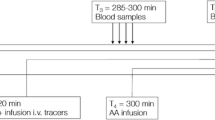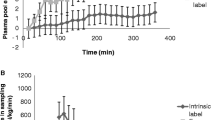Summary
Sepsis is characterized by an abnormal increase in plasma proline (PRO) level, which tends to be related to the severity of disease. This study has been performed to assess the relationship between changes in plasma PRO and levels and doses of other amino acids (AA) in critically ill septic patients undergoing total parenteral nutrition (TPN).
Sixteen septic patients receiving TPN were randomly divided into two groups: 8 patients (Group A) received TPN with a standard AA solution, and 8 patients (Group B) with a modified AA solution (isonitrogenous, branchedchain AA enriched, with unchanged PRO concentration). Serial determinations of plasma AA profiles and of other variables were performed in each patient for a total of 396 measurements. In Group A mean plasma PRO level was 372μM/L; changes in PRO were tightly correlated with changes in the levels of most of the other AA, and the highest PRO levels characterized the more severely unbalanced septic metabolic profiles. In Group B, plasma levels of PRO and of the other AA (except glutamate, aspartate, taurine and the three branched-chain AA) decreased. The decrease in PRO level was well correlated with the increased branched-chain AA dose and with simultaneous decreases in plasma lactate and respiratory quotient. These changes could be related to a specific effect of branched-chain AA on septic metabolic derangement and on PRO metabolism, and to an improved balance between protein synthesis and catabolism.
Similar content being viewed by others
References
1983 Metropolitan height and weight tables. Statistical Bulletin (1984) Metropolitan Life Insurance Company 64: 2–9
Cerra FB, Caprioli J, Siegel JH, McMenamy RR, Border JR (1979a) Proline metabolism in sepsis, cirrhosis and general surgery: the peripheral energy deficit. Ann Surg 190: 577–586
Cerra FB, Siegel JH, Border JR, Peters DM, McMenamy RR (1979c) Correlations between metabolic and cardiopulmonary measurements in patients after trauma, general surgery, and sepsis. J Trauma 19: 621–629
Cerra FB, Siegel JH, Border JR, Wiles J, McMenamy RR (1979c) The hepatic failure of sepsis: cellular versus substrate. Surgery 86: 409–422
Cerra FB, Siegel JH, Coleman B, Border JR, McMenamy RR (1980) Septic autocannibalism. A failure of exogenous nutritional support. Ann Surg 192: 570–580
Chiarla C, Siegel JH, Kidd S, Coleman B, Mora R, Tacchino R, Placko R, Gum M, Wiles CE, Belzberg H, Rivkind A (1988) Inhibition of post-traumatic septic proteolysis and ureagenesis and stimulation of hepatic acute-phase protein production by branchedchain amino acid TPN. J Trauma 28: 1145–1172
Clowes GHA, Heideman M, Lindberg B, Randall HT, Hirsch EF, Cha CJ, Martin H (1980a) Effects of parenteral hyperalimentation on amino acid metabolism in septic patients. Surgery 88: 531–543
Clowes GHA, Randall HT, Cha CJ (1980b) Amino acid and energy metabolism in septic and traumatized patients. JPEN 4: 195–205
Du Bois D, Du Bois EF (1916) A formula to estimate the approximate surface area if height and weight be known. Arch Intern Med 17: 863–871
Giovannini I, Chiarla C, Boldrini G, Castagneto M (1993) Calculation of venoarterial CO2 concentration difference. J Appl Physiol 74: 959–964
Greenspan L, McLellan B, Greig H (1985) AIS and ISS: a scoring chart. J Trauma 25: 60–64
Guidotti GG, Gazzola GC (1992) Amino acid transporters: systematic approach and principles of control. In: Kilberg MS, Häussinger D (eds) Mammalian amino acid transport. Plenum Press, New York, pp 3–29
Hasselgren PO, James JH, Fischer JE (1986) Inhibited muscle amino acid uptake in sepsis. Ann Surg 203: 360–365
Hjelm M, Seakins J, Antoshechkin A (1994) Indications of changed amino acid homeostasis in untreated and treated PKU. Acta Paediatr [Suppl] 407: 57–59
Hjelm M, Seakins JW (1993) Plasma amino acid correlations after intravenous alanine. Amino Acids 5: 431
Hume R (1966) Prediction of lean body mass from height and weight. J Clin Pathol 19: 389–391
Kershenobich D, Garcia-Tsao G, Saldaña SA, Rojkind M (1981) Relationship between blood lactic acid and serum proline in alcoholic liver cirrhosis. Gastroenterology 80: 1012–1015
Kowaloff EM, Phang JM, Granger AS, Downing SJ (1977) Regulation of proline oxidase activity by lactate. Proc Natl Acad Sci 74: 5368–5371
Livesey G, Elia M (1988) Estimation of energy expenditure, net carbohydrate utilization, and net fat oxidation and synthesis by indirect calorimetry: evaluation of errors with special reference to the detailed composition of fuels. Am J Clin Nutr 74: 608–628
Madsen DC (1982) Branched-chain amino acids: metabolic roles and clinical applications. In: Johnston IDA (ed) Advances in clinical nutrition. MTP Press, The Hague, pp 323
Marliss EB, Aoki TT, Toews CJ, Felig P, Connon JJ, Kyner J, Huckabee WE, Cahill GF (1972) Amino acid metabolism in lactic acidosis. Am J Med 52: 474–481
Pearl R, Clowes GHA, Hirsh EF (1985) Prognosis and survival as determined by visceral amino acid clearance in severe trauma. J Trauma 25: 777–783
Pittiruti M, Siegel JH, Sganga G, Coleman B, Wiles CE, Belzberg H, Wedel S, Placko R (1985) Increased dependence on leucine in post-traumatic sepsis: leucine/tyrosine clearance ratio as indicator of hepatic impairment in septic multiple organ failure syndrome. Surgery 98: 378–387
Seber GAF (1977) Linear regression analysis. Wiley, New York
Siegel JH, Cerra FB, Coleman B, Giovannini I, Shetye M, Border JR, McMenamy RH (1979) Physiological and metabolic correlations in human sepsis. Surgery 86: 163–193
Skau T, Nyström PO, Carlsson C (1985) Severity of illness in intraabdominal infection. A comparison of two indexes. Arch Surg 120: 152–158
Skeie B, Kvetan V, Gil KM, Rothkopf MM, Newsholme EA, Askanazi J (1990) Branchchain amino acids: their metabolism and clinical utility. Crit Care Med 18: 549–571
Stevens LE (1983) Gauging the severity of surgical sepsis. Arch Surg 118: 1190–1192
Warner BW, James JH, Hasselgren PO, LaFrance R, Fischer JE (1987) Effect of sepsis and starvation on amino acid uptake in skeletal muscle. J Surg Res 42: 377–382
Wolman SL, Fields ALA, Cheema-Dhadli S, Halperin ML (1980) Protein conversion to glucose: an evaluation of the quantitative aspects. MEN 4: 487–489
Author information
Authors and Affiliations
Rights and permissions
About this article
Cite this article
Chiarla, C., Giovannini, I., Siegel, J.H. et al. Proline metabolism in sepsis. Amino Acids 12, 237–247 (1997). https://doi.org/10.1007/BF01373004
Received:
Accepted:
Issue Date:
DOI: https://doi.org/10.1007/BF01373004




